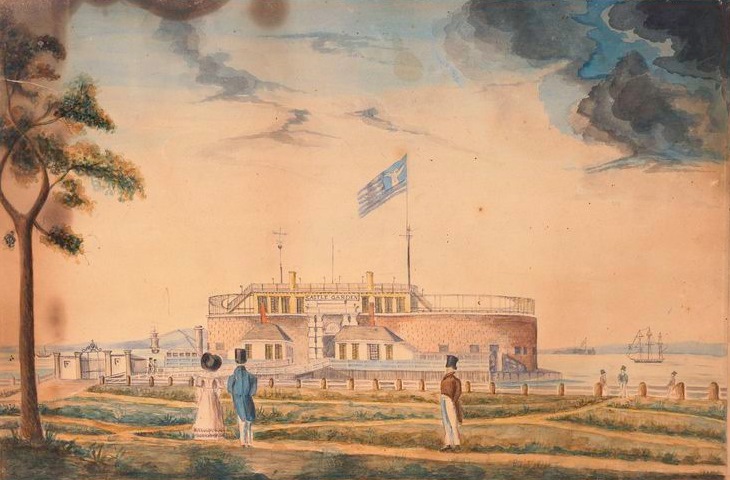The Real NYC #27 - The Battery
Battery Park is a fun place to visit, and has a special
place in my heart. Growing up in NYC I was taken on the trip that almost every
child of my generation went on – across the Harbor on the Staten Island Ferry.
It was an easy way to get out of school on a trip and a free way to see the
Statue of Liberty. And the trip came with time in the park to play and run
around. The Battery also a place that I used as a teacher to demonstrate the
effect of salt water and weather on bronze and granite statues when I taught
chemistry. My students were fascinated by the difference in how bronze statues
were affected by weather in different places. Statues in the center of
Manhattan would turn black, while ones in The Battery were green. This opened
up a whole series of lessons on the chemistry of metals.
 |
| By Alfred Fredericks (Popular Science Monthly Volume 75/Brittanica) [Public domain], via Wikimedia Commons |
Most people know
Battery Park as the place they go to get on the ferry to The Statue of Liberty.
Cool people know that it is where Roberta met Dez while seeking Susan. But few
people know that the park has a history that goes back to the origin Neuw
Amsterdam in 1623.
About the “sale” of Manhattan; while the Dutch thought they
were buying the land, most likely, the Native Americans thought they were
agreeing to a shared use of the land. In Law in American History: Volume 1, law professor G. Edward White interprets
the Manhattan “sale” from the Indians' point of view as “not relinquishing the
island, but simply welcoming the Dutch as additional occupants,” – from www.mentalfloss.com
When the Dutch settled Neuw Amsterdam in 1623, one of the first things that they did was to set up
a battery of cannon to protect their homes from those marauding British
privateers. All along the southern tip of the island of Manhattan guns were
laid to attack any ships that entered the harbor.
Over the centuries the Dutch, British and Americans expanded
and improved the defense of New York City, and by 1812 Castle Clinton had been
built to help protect the city from a British invasion. Castle Clinton sat on
an island off of the coast of Manhattan. After the War of 1812 the fort was renamed
Castle Gardens and operated as one of the premier concert halls for the city.
By the 1850’s the city had used land fill to expand the park, and Castle
Clinton now sat totally landlocked. It became an immigrant welcome center as
boats delivered immigrants from Ellis Island, and 8.6 million people walked
through its walls.
 |
| http://footnotesfromhistory.blogspot.co.uk/2010/07/welcome-to-america.html |
 |
| Immigrants at Castle Garden, New York City, 1866. Wood engraving in "Frank Leslie's Illustrated Newspaper", 20 January 1866, vol. 21, p. 280-281. |
In the 1896, Castle Clinton was the first home to The New
York Aquarium. The Aquarium was housed here until 1941 when Robert Moses
planned to tear down Castle Clinton in order to build the Brooklyn Battery Tunnel.
Luckily there was a movement to preserve this site and while the Aquarium moved
to Coney Island, Castle Clinton stayed put.
 |
| Main entrance to Castle Clinton |
 |
| Interior of the Castle |
 |
| Part of the original battery found during subway construction |
Today Castle Clinton is a National Monument and the ticket
office for ferry to the Statue of Liberty and Ellis Island. There is an ongoing
renovation project at the Castle and the building of the new South Ferry subway
station unearthed part of what is believed to the original battery wall.
Battery Park is 25 acres in size and includes many paths,
memorials and a waterfront promenade. There are too many individual things to
show here, but the
park website shows all of them. Here are some of my favorites:
 |
| Display on Climate Change sponsored by Knowtomorrow.org |
 |
| Front - The Korean War Memorial; Behind - The Sphere (salvaged from the World Trade Center) |
 |
| Giovanni Verrazzano by Etorre Ximenes |
As you might notice, the statue of Verrazzano has undergone restoration, and is no longer useful tp show the effect of weather on bronze.
 |
| The Immigrants by Luis Snguino |
One new addition is the Seaglass Carousel. Here,
one rides in “bio-luminescent” fish, an homage to fact that The Battery was the
original home of the NY Aquarium. The ride is accompanied with a sound and
light show.
So if The Statue of Liberty, Ellis Island or the Staten
Island Ferry are on your plans when you come to New York City, plan some extra
time to spend at The Battery.
Getting There:
Take the #1 train to South Ferry, The #4 and 5 trains to Bowling Green or the R
train to Whitehall Street.
Cost – The Seaglass Carousel costs $5/ride. During the
winter it has very limited hours (Sat/Sun/School holidays)










I really have to learn to pay more attention! I've walked by Battery Park I don't know how many times, but haven't gone in, and clearly have thereby missed a lot. I'm enjoying all the Real NYC pieces!
ReplyDelete